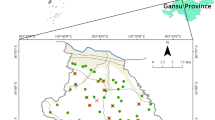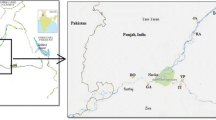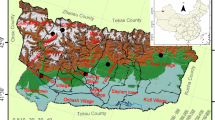Abstract
The present study was conducted to investigate the concentrations of potential toxic metals (PTMs) in agricultural soil (n = 25) and their bioaccumulation in wheat crop (n = 25) collected from alongside the Kurram River, Pakistan. The highest concentrations of Cd, Cr, Cu, Fe, Mn, Ni, Pb, and Zn in soil samples were 0.16, 19.5, 14.7, 46.5, 13.5, 14.5, 14.0, and 19.7 mg kg−1, respectively. In the edible tissues of cultivated wheat crop, the highest concentrations of Cd, Cr, Cu, Fe, Mn, Ni, Pb, and Zn were 0.15, 10.00, 8.75, 22.25, 11.00, 11.25, 10.50, and 7.50 mg kg−1, respectively. The selected PTM concentrations in soil samples were observed within their respective permissible limits set by the Food and Agriculture Organization (FAO) and State Environmental Protection Administration (SEPA) China, while in wheat crops, the Cr and Pb concentrations were above the permissible limits of both FAO and SEPA China. The results showed that the orders of PTMs were Fe > Zn > Cr > Cu > Ni > Pb > Mn in soil and Fe > Ni > Mn > Pb > Cr > Cu > Zn in wheat. The highest PTM concentrations were reported in the sample collected near dumping sites. The results of different soil pollution indices including geo-accumulation index (Igeo), contamination factor (CF), and enrichment factor (EF) indicated that the soil of the study area was moderately to severely contaminated. The ADI values of wheat crops were less than 1, while the HQ varied among different PTMs with the highest value of 2.118 for Pb, and the lowest for Zn (0.007). The results indicated that anthropogenic intervention has made a substantial contribution to soil contamination with PTMs and subsequent uptake by wheat, which may exert potential human health risk.





Similar content being viewed by others
References
Alam, M., Khan, M., Khan, A., Zeb, S., Khan, M.A., Khattak, A.M., Amin, N., & Sajid, M. (2018). Concentrations, dietary exposure and human health risk assessment of heavy metals in market vegetables of Peshawar, Pakistan. Environmental Monitoring and Assessment. 190(9):505. https://doi.org/10.1007/s10661-018-6881-2
Ali, S., Chaudhary, A., Rizwan, M., Anwar, H. T., Adrees, M., Farid, M., Irshad, M. K., Hayat, T., & Anjum, S. A. (2015). Alleviation of chromium toxicity by glycinebetaine is related to elevated antioxidant enzymes and suppressed chromium uptake and oxidative stress in wheat (Triticum aestivum L.). Environmental Science and Pollution Research, 22, 10669–10678.
Ali, J., Khan, M. A., Nazneen, S., Muhammad, J., Nasir, M. J., Shah, M. T., Zahidullah, & Khan, S. (2018). Assessment of heavy metals and physico-chemical characteristics of water and sediments, Kurram River (Pakistan). Journal of Himalayan Earth Sciences, 51(1), 113–126.
Amin, A., Fazal, S., Mujtaba, A., & Singh, S. K. (2014). Effects of land transformation on water quality of Dal Lake, Srinagar, India. Journal of the Indian Society of Remote Sensing, 42(1), 119–128.
Balkhair, K. S., & Ashraf, M. A. (2016). Field accumulation risks of heavy metals in soil and vegetable crop irrigated with sewage water in western region of Saudi Arabia. Saudi Journal of Biological Science, 23, S32–S44.
Basta, N. T., Ryan, J. A., & Chaney, R. L. (2005). Trace element chemistry in residual-treated soil: key concepts and metal bioavailability. Journal of Environmental Quality, 34(1), 49–63.
Chandra, R., Bharagava, R. N., Yadav, S., & Mohan, D. (2009). Accumulation and distribution of toxic metals in wheat (Triticum aestivum L.) and Indian mustard (Brassica campestris L.) irrigated with distillery and tannery effluents. Journal of Hazardous Materials, 162(2), 1514–1521.
Chantachon, S., Kruatrachue, M., Pokethitiyook, P., Tantanasarit, S., Upatham, S., & Soonthornsarathool, V. (2002). Phytoextraction of lead from contaminated soil by vetiver grass (Vetiveria sp.). In 17. World congress of soil science (pp. 14–21). Bangkok.
Chen, Y., Wang, C., & Wang, Z. (2005). Residues and source identification of persistent organic pollutants in farmland soils irrigated by effluents from biological treatment plants. Environment International, 31(6), 778–783.
Chowdhary, P., Yadav, A., Singh, R., Chandra, R., Singh, D. P., Raj, A., & Bharagava, P. M. (2018). Stress response of Triticum aestivum L. and Brassica juncea L. against heavy metals growing at distillery and tannery wastewater contaminated site. Chemosphere, 206, 122–131.
Christou, A., Theologides, C. P., Costa, C., Kalavrouziotis, I. K., & Varnavas, S. P. (2017). Assessment of toxic heavy metals concentrations in soils and wild and cultivated plant species in Limni abandoned copper mining site, Cyprus. Journal of Geochemical Exploration, 178, 16–22.
Dieter, H. H., Bayer, T. A., & Multhaup, G. (2005). Environmental copper and manganese in the pathophysiology of neurologic diseases (Alzheimer’s disease and manganism). CLEAN–Soil Air Water, 33(1), 72–78.
Doabi, S. A., Karami, M., Afyuni, M., & Yeganeh, M. (2018). Pollution and health risk assessment of heavy metals in agricultural soil, atmospheric dust and major food crops in Kermanshah province, Iran. Ecotoxicology and Environmental Safety, 163, 153–164.
FAO/WHO, (2001). Food Additives and Contaminants. Codex Alimentarius Commission, pp. 1-289. Joint FAO/WHO Food Standards Program, ALI-NORM 01/12A.
Gao, X., & Chen, C. T. A. (2012). Heavy metal pollution status in surface sediments of the coastal Bohai Bay. Water Research, 46(6), 1901–1911.
GFBIC (2014). Good Food Box for the Iranian community, Ministry of Health, Medical and Education, published by Andishe Mandegar, Qom. Pp 26.
Gupta, U. C., & Gupta, S. C. (1998). Trace element toxicity relationships to crop production and livestock and human health: implications for management. Communications in Soil Science and Plant Analysis, 29(11–14), 1491–1522.
Gupta, A. K., & Sinha, S. (2008). Decontamination and/or revegetation of fly ash dykes through naturally growing plants. Journal of Hazardous Materials, 153, 1078–1087.
Hakanson, L. (1980). An ecological risk index for aquatic pollution control. A sedimentological approach. Water Research, 14, 975–1001.
Hussain, I., Khan, M. A., & Ali, K. (2011). Comparative studies of heavy metals in wheat growing in different environmental conditions. Journal of the Chemical Society of Pakistan, 33(4), 499–502.
Hussain, R., Khattak, S. A., Shah, M. T., & Ali, L. (2015). Multistatistical approaches for environmental geochemical assessment of pollutants in soils of Gadoon Amazai Industrial Estate, Pakistan. Journal of Soils and Sediments, 15, 1119–1129.
Iyengar, G. V., & Nair, P. P. (2000). Global outlook on nutrition and the environment: meeting the challenges of the next millennium. Science of the Total Environment, 249(1), 331–346.
Khan, S., Cao, Q., Zheng, Y. M., Huang, Y. Z., & Zhu, Y. G. (2008). Health risks of heavy metals in contaminated soils and food crops irrigated with wastewater in Beijing, China. Environmental Pollution, 152, 686–692.
Khan, S., Rehman, S., Khan, A., Khan, M. A., & Shah, M. T. (2010). Soil and vegetables enrichment with heavy metals from geological sources in Gilgit, northern Pakistan. Ecotoxicology and Environmental Safety, 73, 1820–1827.
Khan, K., Lu, Y., Khan, H., Ishtiaq, M., Khan, S., Waqas, M., Wei, L., & Wang, T. (2013). Heavy metals in agricultural soils and crops and their health risks in Swat District, northern Pakistan. Food and Chemical Toxicology, 58, 449–458.
Khan, A., Khan, S., Khan, M. A., Qamar, Z., & Waqas, M. (2015). The uptake and bioaccumulation of heavy metals by food plants, their effects on plants nutrients, and associated health risk: a review. Environmental Science and Pollution Research, 22, 13772–13799. https://doi.org/10.1007/s11356-015-4881-0.
Khan, A., Khan, S., Alam, M., Khan, M. A., Aamir, M., Qamar, Z., Rehman, Z. U., & Perveen, S. (2016). Toxic metal interactions affect the bioaccumulation and dietary intake of macro- and micro-nutrients. Chemosphere, 146, 121–128.
Khan, A., Khan, S., Khan, M. A., Aamir, M., Ullah, H., Nawab, J., Rehman, I. U., & Shah, J. (2019). Heavy metals effects on plant growth and dietary intake of trace metals in vegetables cultivated in contaminated soil. International journal of Environmental Science and Technology, 16, 2295–2304. https://doi.org/10.1007/s13762-018-1849-x.
Küpper, H., Mijovilovich, A., Meyer-Klaucke, W., & Kroneck, P. M. H. (2004). Tissue and age-dependent differences in the complexation of cadmium and zinc in the cadmium/zinc hyperaccumulator Thlaspi caerulescens (Ganges ecotype) revealed by X-ray absorption spectroscopy. Plant Physiology, 134, 748–757.
Lin, Q., Liu, E., Zhang, E., Li, K., & Shen, J. (2016). Spatial distribution, contamination and ecological risk assessment of heavy metals in surface sediments of Erhai Lake, a large eutrophic plateau lake in southwest China. CATENA 145, 193–203.
Liu, B., Ai, S., Naeem, S., Ding, J., Ji, W., & Zhang, Y. (2018a). Metal bioaccessibility in a wastewater irrigated soil-wheat system and associated human health risks: implications for regional thresholds. Ecological Indicators, 94, 305–311.
Liu, J. J., Ni, Z. X., Diao, Z. H., Hu, Y. X., & Xu, X. R. (2018b). Contamination level, chemical fraction and ecological risk of heavy metals in sediments from Daya Bay, South China Sea. Marine Pollution Bulletin, 128, 132–139.
Mac Caferri, M., Sanguineti, M. C., Giuliani, S., & Tuberosa, R. (2009). Genomics of tolerance to abiotic stress in the Triticeae. In: Feuillet, C., Muehlbauer, G.J. (Eds.), Plant genetics and genomics: crops and models 1:7 genetics and genomics of the Triticeae. Springer, New York, pp. 481–558.
Manu, A., Bala, K., Shwta, R., Anchal, R., Barinder, K., & Neeraj, M. (2008). Heavy metals accumulation in vegetables irrigated with water from different sources. Food Chemistry, 11, 811–815.
McLaughlin, M. J., Tiller, K. G., Naidu, R., & Stevens, D. P. (1996). The behaviour and environmental impact of contaminants in fertilizers. Soil Research., 34(1), 1–54.
Muhammad, S., Shah, M. T., & Khan, S. (2011). Health risk assessment of heavy metals and their source apportionment in drinking water of Kohistan region, northern Pakistan. Microchemical Journal, 98(2), 334–343.
Muller G. (1969). Index of geoaccumulation in sediments of the Rhine River.
Mutuma, S., Amuna, P., Shukla, H., & Sumar, S. (1999). Chromium in food, nutrition and health-an introduction. Nutrition & Food Science, 99(2), 81–88.
Nazeer, S., Hashmi, M. Z., & Malik, R. N. (2014). Heavy metals distribution, risk assessment and water quality characterization by water quality index of the River Soan, Pakistan. Ecological Indicators, 43, 262–270.
Pandey, B., Suthar, S., & Singh, V. (2016). Accumulation and health risk of heavy metals in sugarcane irrigated with industrial effluent in some rural areas of Uttarakhand, India. Process Safety and Environment Protection, 102, 655–666.
PARC. (1989). Pakistan agricultural research council. Islamabad: Wheat Research and Development in Pakistan.
Rahaie, M., Xue, G. P., & Schenk, P. M. (2013). The role of transcription factors in wheat under different abiotic stresses. In K. Vahdati & C. Leslie (Eds.), Abiotic stress - plant responses and applications in agriculture (pp. 367–385). Rijeka: InTech.
Rattan, R. K., Datta, S. P., Chhonkar, P. K., Suribabu, K., & Singh, A. K. (2005). Long-term impact of irrigation with sewage effluents on heavy metal content in soils, crops and groundwater—a case study. Agriculture, Ecosystems and Environment, 109(3), 310–322.
Rehman, I. U., Ishaq, M., Ali, L., Khan, S., Ahmad, I., Din, I. U., & Ullah, H. (2018). Enrichment, spatial distribution of potential ecological and human health risk assessment via toxic metals in soil and surface water ingestion in the vicinity of Sewakht mines, district Chitral, Northern Pakistan. Ecotoxicology and Environmental Safety, 154, 127–136.
Sakan, S. M., Đorđević, D. S., Manojlović, D. D., & Predrag, P. S. (2009). Assessment of heavy metal pollutants accumulation in the Tisza river sediments. Journal of Environmental Management, 90, 3382–3390.
Sanita di Toppi, L., & Gabbrielli, R. (1999). Response to cadmium in higher plants. Environmental and Experimental Botany, 41(2), 105–130.
Satarug, S., Haswell-Elkins, M. R., & Moore, M. R. (2000). Safe levels of cadmium intake to prevent renal toxicity in human subjects. British Journal of Nutrition, 84(6), 791–802.
Saxena, I., & Shekhawat, G. S. (2013). Nitric oxide (NO) in alleviation of heavy metal induced phytotoxicity and its role in protein nitration. Nitric Oxide, 32, 13–20.
SEPA (2005). State Environmental Protection Administration. China, Gb: 2005. The Limits of Pollutants in Food. pp. 2762.
Shah, M. T., Ara, J., Muhammad, S., Khan, S., & Tariq, S. (2012). Health risk assessment via surface water and sub-surface water consumption in the mafic and ultramafic terrain, Mohmand agency, northern Pakistan. Journal of Geochemical Exploration 118, 60–67.
Sharma, S., Nagpal, A. K., & Kaur, I. (2018). Heavy metal contamination in soil, food crops and associated health risks for residents of Ropar wetland, Punjab, India and its environs. Food Chemistry, 255, 15–22.
Solgi, E., Esmaili-Sari, A., Riyahi-Bakhtiari, A., & Hadipour, M. (2012). Soil contamination of metals in the three industrial estates, Arak, Iran. Bulletin of Environmental Contamination and Toxicology, 88(4), 634–638.
USEPA. (2005). (United States Environmental Protection Agency) Guidelines for carcinogen risk assessment. Risk Assessment Forum; Washington, DC. EPA/630/P-03/001F
USEPA (2015). United States Environmental Protection Agency. Risk based screening table-generic, summary table. United States Environmental Protection Agency. http://www.epa.gov/risk/risk-based-screening-table-generic-tables. Accessed 23 May 2016.
Varol, M. (2011). Assessment of heavy metal contamination in sediments of the Tigris River (Turkey) using pollution indices and multivariate statistical techniques. Journal of Hazardous Materials, 195, 355–364.
Wan, N., Ji, X., Jiang, J., Qiao, H., & Huang, K. (2013). A methodological approach to assess the combined reduction of chemical pesticides and chemical fertilizers for low-carbon agriculture. Ecological Indicators, 24, 344–352.
Wang, G., Su, M. Y., Chen, Y. H., Lin, F. F., Luo, D., & Gao, S. F. (2006). Transfer characteristics of cadmium and lead from soil to the edible parts of six vegetable species in southeastern China. Environmental Pollution, 144(1), 127–135.
Waqas, M., Khan, S., Chao, C., Shamshad, I., Qamar, Z., & Khan, K. (2014). Quantification of PAHs and health risk via ingestion of vegetable in Khyber Pakhtunkhwa Province, Pakistan. Science of the Total Environment, 497, 448–458.
Zhang, J., & Liu, C. (2002). Riverine composition and estuarine geochemistry of particulate metals in China—weathering features, anthropogenic impact and chemical fluxes. Estuarine Coastal Shelf Science 54, 1051–1070.
Zhang, M. K., Liu, Z. Y., & Wang, H. (2010). Use of single extraction methods to predict bioavailability of heavy metals in polluted soils to rice. Communications in Soil Science and Plant Analysis, 41(7), 820–831.
Funding
This study was financially supported by the Higher Education Commission (HEC) of Pakistan under indigenous scholarship (117-11538-PS7-032 (50019083).
Author information
Authors and Affiliations
Corresponding authors
Additional information
Publisher’s note
Springer Nature remains neutral with regard to jurisdictional claims in published maps and institutional affiliations.
Electronic supplementary material
ESM 1
(DOC 349 kb)
Rights and permissions
About this article
Cite this article
Ali, J., Khan, S., Khan, A. et al. Contamination of soil with potentially toxic metals and their bioaccumulation in wheat and associated health risk. Environ Monit Assess 192, 138 (2020). https://doi.org/10.1007/s10661-020-8096-6
Received:
Accepted:
Published:
DOI: https://doi.org/10.1007/s10661-020-8096-6




